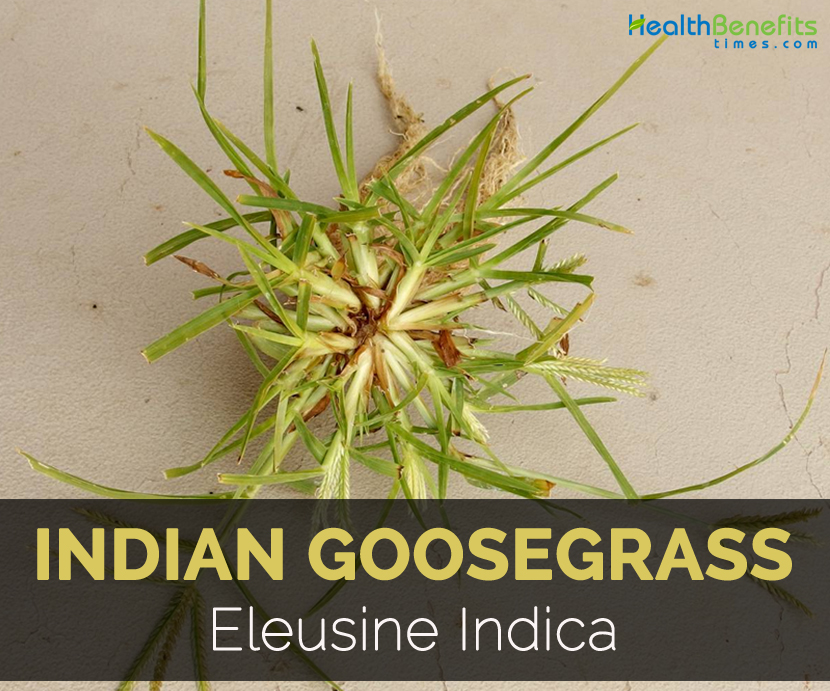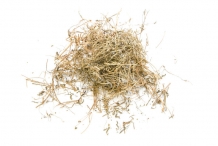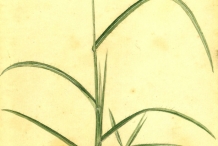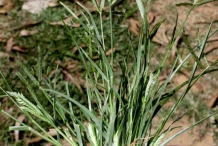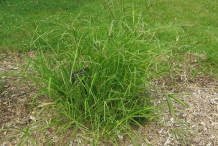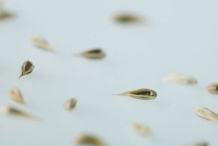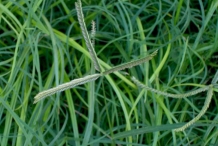Eleusine indica is an annual plant which grows to the height of 1/2-2 feet tall. Leaves are placed towards the culms base which is glabrous, green and flattened. Leaf blades are 8 mm across and 10 inches long, mostly glabrous, medium to dark green, keeled and have hull shaped tips. Margins found on leaf blades are sparsely ciliate having long crooked hairs. Leaf sheaths loosely wrap around culms and are somewhat overlapping and flattened. The surface of leaf sheath is white to medium green, glabrous and longitudinally veined. A culm bears whorl of 2 to 8 floral spikes on apex of basal stalk. It has 1 to 2 individual spikes which are found lower on peduncle. Floral spikes are straight or slightly curved, ascending or spreading widely measuring 2 to 6 inches long. All floral spike possess two dense rows of sessile spikelets on one side of rachis which is glabrous, green and flattened on exposed side. Spikelets while immature are light green which becomes silvery white to silvery red on blooming period. Lemmas are overlapping which are composely appressed. Both lemmas and glumes are keeled, elliptic or lanceolate with thin textured. Upper glume is 2 to 3 mm long and lower glume is 1.5 to 2.5 mm long. Lemmas are 2 to 3.5 inches long. The flower blooms during summer though some plants might bloom on early autumn. Eventually after that, spikelets changes to brown. Fertile lemmas have 1 to 1.5 mm long grains which are ovoid, dark brown, flattened with rough texture. Grains possess several fine ridges on one side which radiates from center towards the margins.
History
Goosegrass is inherent to Eurasia but it has been a troublesome weed for several decades in Tennessee row crops. It could be found in agronomic crops, orchards, pastures, waste areas and roadsides. It has some history of resistance development to herbicides.
Health Benefits of Indian Goosegrass
Some of the health benefits of Indian Goosegrass are:
- Anti-cancer activity
Indian Goosegrass has anticancer and antioxiant activities which helps to prevents the growth of cancer cells in the body. It effectively eliminates myoma and ovarian cyst. The regular consumption of tea in the morning or before bed in evening will disappear cyst.
- Kidney ailments
These plants possess natural diuretic which promotes the amount of water in the body. It eliminates toxins and other agents through urine which helps to keep the kidney problems at bay.
- Helpful for wounds, arthritis and parasites
Arthritis is a common sickness found on elders that could be prevented when this plant is applied on affected area. Put the mix of this plant and scraped coconut till it becomes hot and bandage it on the area with pain. It is used in wounds to stop bleeding. Being a strong laxative, it eliminates worms and parasites from stomach.
- Diabetes and high blood pressure
The daily consumption of Indian Goosegrass tea eliminates diabetes and high blood pressure. It also lowers temperature of the body by providing relief from fever and also eliminates dandruff from hair. This plant is also effective in curing other illnesses such as hemoptysis, liver problems, bladder disorders, malaria, jaundice, epilepsy and infertility in women.
Traditional uses
- In Vietnam and India, it is used for treating liver problems.
- In Vietnamese traditional medicine, the herbal mixture of various plants is used for influenza, liver ailments and oliguria.
- This plant is used for curing malaria, fever and yellowish urine.
- In Malaysia, leaves juices are prescribed after childbirth to women to discharge placenta.
- The decoction of leaves is used in Sumatra as anthelmintic.
- In Kampuchea, root is used for fevers and liver complaints.
- The mixture of gogo and Indian goosegrass plant is used for eliminating dandruff and also to prevent hair loss.
- The plant decoction is used in India for dysentery and hemoptysis.
- Poultice made from leaves are used for injuries and sprains.
- Root decoction is used to treat fever.
- The plant decoction is used to provide relief from abdominal muscle strain and also applied to wound to stop bleeding in Guyana.
- The grass decoction is used as a tonic for bladder disorders.
- The decoction prepared from seeds is prescribed for infants with black jaundice in Venezuela.
- The plant decoction is used to cure dysentery, diarrhea and muscle spasms in Colombia.
- In Tobago and Trinidad, plant is used for treating kidney problems.
- In Madagascar, plant is boiled and used to cure sprains.
- In Madagascar, leaves are externally used for strained joints and sprains.
- In Benin, roots of Indian goosegrass are used to cure diarrhea and pulped roots for fractures.
- In People’s Republic of Congo, the decoction prepared from whole plant is used to treat urogenital infections.
- In Togo, ripe fruit of Aframomum and shoot and leaves of Eleusine Indica are powdered and are diluted in lemon juice and taken orally for cardiac pain.
- Apply the sap on wounds, cuts and injuries.
- Use the poultice for treating skin problems such as eczema and psoriasis, scrapes and minor cuts.
- For diarrhea, boil 20 g of washed roots in 1 liter of water for about five minutes. Strain it in a container and drink it as tea four times in a day.
- For body pains and sprains, apply the poultice of heated pounded leaves on affected areas. Change it after every four hours.
- For hair loss and dandruff, combine minced leaves, stem in coconut oil and let it remain for 15 minutes. Apply this oil mixture to scalp and leave it for 30 minutes then wash hair.
- Root decoction is helpful for fever.
- The decoction prepared from roots is used as a cure for asthma in Malaysia.
- In Myanmar, leaves are helpful for hypertension.
Precautions
- Avoid by allergic people to prevent allergic reactions.
- Consume it in limited amounts.
How to Eat
- Seeds are cooked in whole or grounded into flour and used for making gruels, cakes and alcoholic beverages.
- Young plants are consumed raw or cooked and is served as a side dish with rice.
- Roots are also consumed raw.
- Boil the shoots of Goosegrass and serve it with butter or olive oil seasoned with pepper and little salt.
- Ripe Goosegrass seeds are roasted in low temperature. It is grinded and used as a substitute for non-caffeinated coffee.
- Young shoots could be added to soups, omelets and salads.
References:
https://www.itis.gov/servlet/SingleRpt/SingleRpt?search_topic=TSN&search_value=41692#null
https://en.wikipedia.org/wiki/Eleusine_indica
http://natureconservation.in/goose-grass-eleusine-indica-complete-detail-updated/
http://tiredmama-ph.blogspot.com/2017/11/goosegrassparagis-10-potential-health.html
http://www.stuartxchange.com/Paragis
https://www.cropscience.bayer.com/en/crop-compendium/pests-diseases-weeds/weeds/eleusine-indica
http://www.pinoyhealthyinfo.com/2017/10/health-benefits-of-paragis-or-goose.html
Comments
| Indian Goosegrass Quick Facts | |
|---|---|
| Name: | Indian Goosegrass |
| Scientific Name: | Eleusine Indica |
| Origin | Indian Goosegrass is inherent to Africa, but naturalized in South America, Micronesia, Asia, American Samoa and the Pacific Islands from the tropical to subtemperate regions. |
| Colors | Reddish brown to black |
| Shapes | Oblong-ovate, 1 to 1.5 mm. long |
| Health benefits | Anti-cancer activity, Kidney ailments, Helpful for wounds, arthritis and parasites, Diabetes and high blood pressure |
| Name | Indian Goosegrass |
|---|---|
| Scientific Name | Eleusine Indica |
| Native | Indian Goosegrass is inherent to Africa, but naturalized in South America, Micronesia, Asia, American Samoa and the Pacific Islands from the tropical to subtemperate regions. |
| Common/English Name | Indian goosegrass, Crowfootgrass, Wiregrass, Crab Grass, Crabgrass, Crowsfoot grass, Fowl foot grass, Fowl-foot Grass, Goose grass, Goosefoot grass, Goosegrass, Indian goose grass, Indian goosegrass, Man grass, Man-grass, Bullgrass, Crabgrass, Crow’s Foot, Dog Grass, Foul Foot, India Goosegrass, Indian Goosegrass, Iron Grass, Silver Crabgrass, Wire Grass, Yard Grass, Yardgrass, Silver crabgrass |
| Name in Other Languages | Arabic: Kalassindra; Bangladesh: Binna Chall, Gaicha, Chapra, Malangakuri; Benin:- Bariba: Gamatori, Gomateri, Berba: Tchouan, Yom:Torohundo; Brazil (Portuguese): Ca-A Pi-1, Capim Pe Da Galinha, Capim Criador, Capim-Da-Cidade, Grama-De-Coradoura, Capim-De- Burro, Grama-De-Coradouro, Grama De Sapo; Burmese: Myet-Thakwa, Se-Gwa, Sin Ngo Myet, Sin Ngo Let Kya; Cambodia: Smao Choeng Tukke; Cameroon: Esinge-Singe, Who; Central African Republic: Ndili; Chad: Kalassindra; Chamorro: Umog; Chinese: Niu Jin Cao, 牛筋草, Xīshuài cǎo (蟋蟀草); Chuukese: Fatil; Cook Islands: Mārōki‘Aki‘A, Matie, ‘Ātangaroa, Matie Tūtae-Kuri, Mauku; Côte D’ivoire:- Aboure: Assumoamata, Essouéma, Ashanti: Kama, Baoule: Siganzi, Ebrie: N’tema, Shien: Kpédé, Kwédé; Cuba: Pata De Gallina, Grama De Caballo; East Africa:- Ateso: Ekitu, Ankole: Orutar-Atari, Ekegusii: Ribanchore, Kiswahili: Malulu, Kipsigis: Bek, Masai: Enguruma, Ruganda: Kasibauti; Egypt: Negil; Fijian: Kavoronaisivi, Vorovoroisivi; French: Pied De Poule De L’inde, Chiendent Patte De Poule, Eleusine D’Iindes, Pied De Poule, Eleusine Des Indes, Pied Poule Vrai; Germany: Indische Indica; Ghana: Nsensan; Hawaiian: Mānienie Ali‘I; India:- Bengali: Binna Challa, Gaicha, Chapra, Malangakuri, Gujarati: Bajari, Hindu: Jangali Marua, Ghoraya, Jhingari, Kannada: Ragi, Maharashtra: Mahaar, Naachni, Marathi: Nachani, Orissa: Nandimukha, Nandiaa, Oriya: Mandiaa, Punjabi: Bajra, Tamil: Kevuru, Kelvaraku, Thippa Ragi, Telugu: Ragi, Urdu: Chhota Madhana, Madhani Cheera, I-Kiribati: Te Uteute, Te Uteute Na Banabana Indonesia:- Sundanese: Jukut Jampang Ede, Jukut Jampang, Jukut Jampang Munding, Jukut Charulang, Javanese: Godong Ula, Rumput Welulang, Suket, Lulangan, Sukut Chelulang, Suket Welulang, Sumatra: Sambau, Sarut; Italian: Panico Indiano; Japanese: Ohi Shiba, Chikaragusa, Ohi Jiwa; Kosraean: Mahkwekwe; Laotian: Nya Phak Kole; Libya: Negil; Madagascar: Tsiavotraombilahy, Tsipihipihina, Tsimpignipgny; Malawi: Chinsanwi, Chipikamongu, Chigombe, Kanggodza; Malaysia: Rumput Sambari, Godong Ula, Rumput Sambau; Marshallese: Katejukjuk; Nepalese: Kode, Kodo Ghans, Kode Vanso; Nicaragua: Yerba De Camino; Niger: Tuji; Nigeria:- Igbo: Ichite, Yoruba: Gbegin; Niuean: Mosie Fuhitalo, Mosie Fahitalo, Mosie Fuhitalotalo; Palauan: Deskim, Keteketarmalk, Kelelamalk; Papua New Guinea:- Agenehembo, Northern Province: Hiroi, Kurereda, Northern Province: Kiroi, Quaqua, Morobe Province: Iquazi; Paraguay: Yerba De Camino; Philippines:- Bikol: Barañgan, Bisaya: Bugtusan, Palagtiki, Cebu Bisaya: Palad, Ifugao: Dinapaiuk, Iloko: Parañgis, Pampangan: Parañgis- Sabuñgan, Sabung-Sabuñgan, Panay Bisaya: Bila-Bila, Sulu: Bikad-Bikad, Tagalog: Bakis- Bakisan, Kabit-Kabit, Gagabutan, Paragis, Sabung- Sabuñgan, Sabung-Sabuñgan Sabung- Sabuñgan, Sambali; Pohnpeian: Reh Takai; Portuguese: Pata De Galinha, Capim De Caradouro. Capim De Caradouro, Capim-De-Burro, Capim-Da- Cidade, Capim-Pé-De- Galinha, Grama-Sapo, Grama-De- Coradouro, Pata De Galinha, Pe-De-Galo; Pukapukan: Veyaveya; Rakahanga-Manihiki: Mauku Vai-Rakau; Reunion: Chiendent, Siendan; Russian: Elevzina Indiiskaia; Samoan: Fahitalo, Lau Ta‘A Ta‘A, Fahitalo, Sefa, Ta‘A Ta‘A; Satawalese: Puker; Senegal: Ratam Fa Mbe, Gondirima, Vodvod; Shona: Makha; Sierra Leone: Ngetaewuli, Eleusine indica; South Africa: Indiese Osgras, Jongos Gras; Spanish: Eleusine, Grama De Orqueta, Grama De Caballo, Grama Dulce, Guarataro, Hierba Dulce, Olotillo, Natajo Dulce, Pata De Gallina, Pata De Ganso, Pata De Gallo, Yerba De Camino, Yerba Dulce; Swedish: Gåshirs; Tahitian: Tamamau, Tamaomao; Taiwan: Nui Chin Tsao; Thailand: Yaa Teen-Ka; Tongan: Mohuku Siamane, ‘A Leala, Takataka, A Le Ala; Togo: Adon’doulé, Tchama; Tongarevan: Mauku; Uganda: Kasbanti; Ulithian: Fathil; Vietnam:- Tày: Cỏ Mần Trầu, Ngưu Cần Thảo, Tết Suất Thảo, Cỏ Vườn Trầu, Màng Trầu, Cỏ Chỉ Tía, Thanh Tâm Thảo, Ngưu Cân Thảo, Hang Ma, Thái: Co Nhả Hút, Dao: Hìa Xú Xan, Ba Na: Cao Day, K’ho: Hất T’rớ Lạy, H’dong: R’day; Zambia: Rapoka; Zimbawe: Mu Kha |
| Plant Growth Habit | Annual or short-lived perennial |
| Plant Size | ½ to 2 feet tall |
| Spikes | 2-6 inches long, straight or slightly curved |
| Leaves | 5-25 x 0.4-0.6 cm, linear-lancoleate or linear, narrow |
| Flowering Season | June to October |
| Grains shape & size | Oblong-ovate, 1 to 1.5 mm. long |
| Color | Reddish brown to black |


